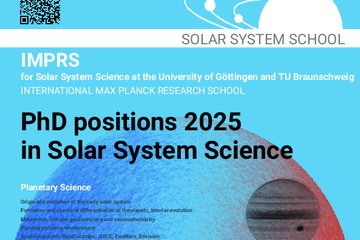All genres
41.
Journal Article
Transits of extrasolar moons around luminous giant planets. Astronomy and Astrophysics 588, A34 (2016)
42.
Journal Article
Ist da jemand? Die Entdeckung der Erde durch Außerirdische. Abenteuer Astronomie 3, pp. 20 - 25 (2016)
43.
Journal Article
Modeling the Orbital Sampling Effect of Extrasolar Moons. Astrophysical Journal 820 (2), 88 (2016)
44.
Journal Article
Predictable patterns in planetary transit timing variations and transit duration variations due to exomoons. Astronomy and Astrophysics 591, A67 (2016)
45.
Journal Article
The search for extraterrestrial intelligence in Earth's solar transit zone. Astrobiology 16 (4), pp. 259 - 270 (2016)
46.
Journal Article
How eclipse time variations, eclipse duration variations and radial velocities can reveal S-type planets in close eclipsing binaries. Mon. Not. Roy. Astron. Soc. 466, pp. 4683 - 4691 (2016)
47.
Book Chapter
Detecting and Characterizing Exomoons and Exorings. In: Handbook of Exoplanets, pp. 835 - 851 (Eds. Deeg, H. J.; Belmonte, J. A.). Springer, Cham (2018)
48.
Talk
Extrasolare Monde. Studium Generale, Arbeitskreis Astronomie, Universität Stuttgart, Online (2021)
49.
Talk
Aufbruch zu den Exoplaneten. Vortragsreihe: Die Zukunft im All, Online (2021)
50.
Talk
Predicted Yield of Earth-like Planets from PLATO. PLATO Week 12, Online (2021)
51.
Talk
New Predictions of PLATO's Yield of Earth-sized Transiting Planets in the Habitable Zone of Sun-like Stars. SPP1992 all-hands-on-deck meeting, Online (2021)
52.
Talk
Analytic Solutions to Exoplanet Transit Depth for Ad Hoc Limb Darkening Laws. Getting Ultra-Precise Planetary Radii with PLATO: The Impact of Limb Darkening and Stellar Activity on Transit Light Curves, Online (2021)
53.
Talk
Habitability of early Earth:Liquid water under a faint young Sunand tidal heating due to a closer Moon. GeoKarlsruhe 2021: Sustainable Earth - from processes to resources, Online (2021)
54.
Talk
Earth-sized Transiting Planets in the Stellar Habitable ZonesFrom Kepler to PLATO. Virtual Annual meeting of the German Astronomical Society, Online (2021)
55.
Talk
Extrasolare Planeten. Studium Generale, Arbeitskreis Astronomie, Universität Stuttgart, online (2021)
56.
Talk
Outlier detection algorithms for light curves, center of brightness, and imagettes of the PLATO mission. Plato Week 11, online (2021)
57.
Talk
Habitability of early Earth: Liquid water under a faint young Sun and tidal heating due to a closer Moon. General Meeting of the SPP 1833 "Building a Habitable Earth", online (2021)
58.
Talk
Ursprung – Kann etwas aus dem Nichts entstehen? Podiumsdiskussion (Ringvorlesung der Georg-August-Universität Göttingen), online (2021)
59.
Talk
Extrasolare Planeten. Helene-Lange-Schule Hannover, online (2021)
60.
Talk
Challenges of Validating Earth-like Transiting Planets Around Sun-like Stars. Splinter session "Exploring the diversity of extrasolar planets”, Virtual Meeting of the German Astronomical Society (2020)











